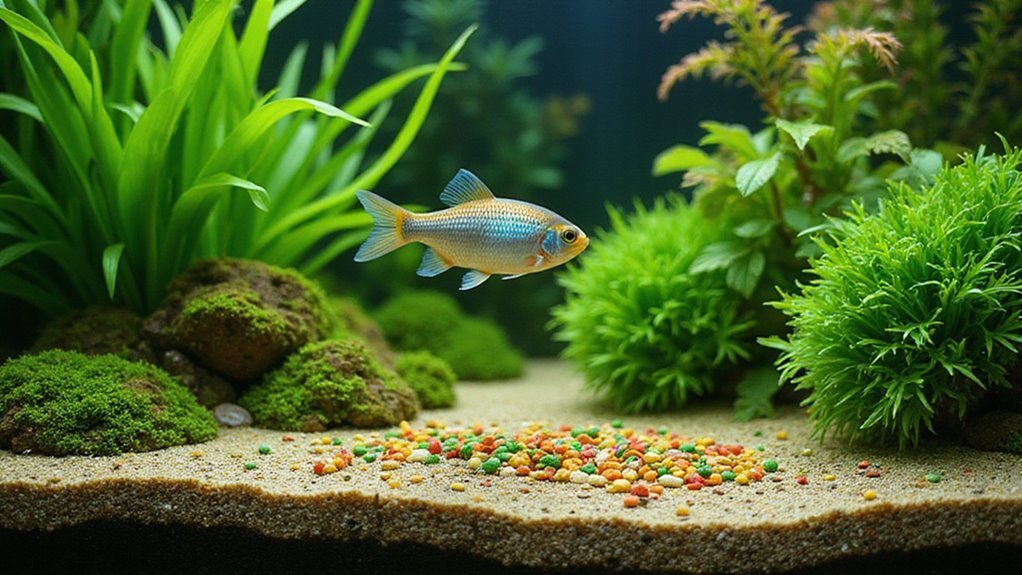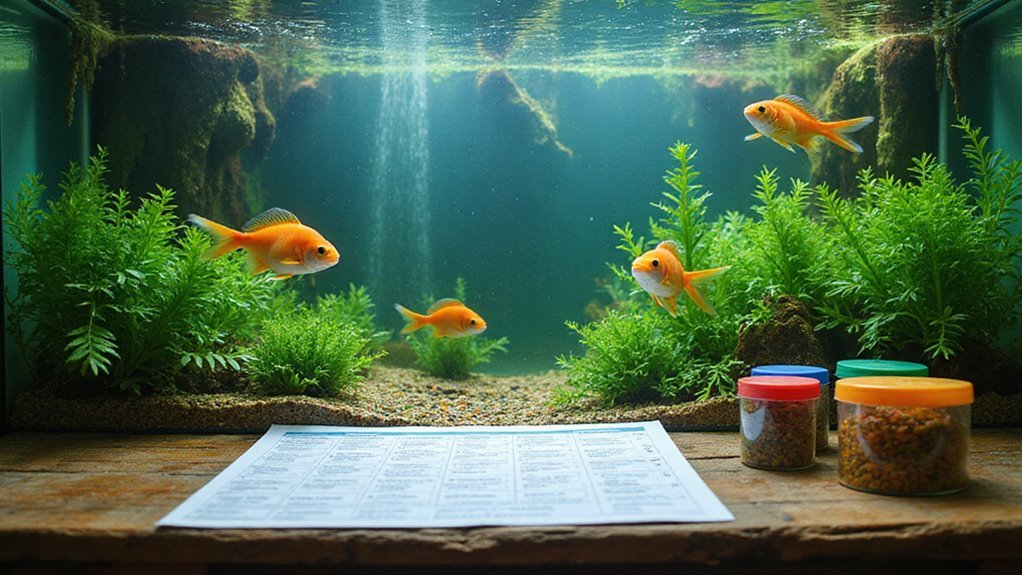You know how a compost pile needs the right ingredients to break down properly? Well, that’s exactly what we’re dealing with when it comes to finding fish food that’ll kick-start our tank’s nitrogen cycle. Let me tell you, I’ve tested dozens of foods over the years, and not all protein sources are created equal. So, want to know which foods will give you that perfect ammonia boost without turning your tank into a murky mess? Let’s figure this out together.
Understanding Ammonia Release From Fish Food

When you’re setting up a new aquarium, understanding how fish food releases ammonia is a total game-changer.
Here’s the cool thing – as fish food breaks down, it naturally releases ammonia through decomposition, which is exactly what we need for cycling tanks.
You know what’s interesting? Flake foods work better than pellets because they break down faster.
If you’re using high-protein options, you’ll get even more ammonia release – perfect for kickstarting bacterial growth! Just toss in a daily pinch, and you’re good to go.
Just remember to keep monitoring ammonia levels to protect your aquatic life. It’s important to note that regular water changes are essential for preventing dangerously high ammonia levels. Pretty neat, right?
Top Fish Foods for Tank Cycling
You know what’s super interesting about tank cycling? The right fish food can make all the difference!
We’ve found that high-protein options like premium flakes and sinking pellets are absolute champions for kickstarting the cycling process.
Here’s the cool part – foods made from shrimp meal or fish meal break down steadily, feeding those beneficial bacteria we’re trying to grow. Freeze-dried bloodworms and brine shrimp work great too!
Just remember to use a daily pinch of your chosen food and let it stay uneaten for a bit.
Want our top pick? Fish food flakes with complex proteins – they’re perfect for creating that ammonia-rich environment your tank needs. Additionally, being aware of the ammonia in food production can help you make smarter choices for your aquarium’s ecosystem.
Protein Content and Decomposition Rates

Let’s talk about what really makes fish food break down during cycling – it’s all about the protein!
You know what’s interesting? High-protein fish foods, especially those packing 40-55% protein, are cycling superstars for ammonia production.
Here’s a cool tip: flake foods break down faster than pellets, so they’ll kickstart those beneficial bacteria quicker.
But watch those feeding amounts – too much food can mess with your water quality. Think of it like this: complex proteins are like time-release capsules for ammonia, while simple carbs just don’t cut it.
Want better results? Keep testing those ammonia levels to see how well your food’s working! Additionally, using organic fish food can provide a more balanced nutrient profile, supporting healthier fish and better water quality.
Monitoring Water Parameters During Cycling
Since testing water parameters is the key to successful cycling, we’ve got to stay on top of our daily measurements.
You know what’s neat? Using liquid test kits gives us super accurate readings of ammonia, nitrite, and those all-important pH levels.
Here’s a pro tip: keep adding fish food consistently to feed those beneficial bacteria – they’re the powerhouse of your nitrogen cycle!
Trust me, it takes patience, but watching those ammonia and nitrite levels drop to zero is so satisfying.
Want to know the secret? Just adjust your feeding practices based on your test results, and you’ll avoid those nasty parameter spikes. Regular monitoring of key water quality indicators ensures a balanced pond ecosystem, which ultimately supports healthy fish and plants.
Proper Dosing Methods and Feeding Schedule

When it comes to getting those fish food amounts just right, we’re talking about a delicate balance. You know what’s cool? A daily pinch is all you need to maintain steady ammonia levels for those beneficial bacteria to thrive during the cycling process.
| Time | Action | Target |
|---|---|---|
| Morning | Add pinch | 3-5 ppm |
| Afternoon | Monitor ammonia | Maintain levels |
| Evening | Water testing | Adjust if needed |
Hey, here’s a pro tip: reduce dosage if ammonia spikes above 5 ppm. Keep that feeding schedule consistent – just enough for a one-minute feeding. Trust me, this steady release approach works like a charm! Want to know if you’re doing it right? Daily testing tells the whole story.
Common Issues and Troubleshooting Tips
Although adding fish food to cycle your tank might seem straightforward, you’ll probably run into a few hiccups along the way – and that’s totally normal!
Hey, let’s talk about the biggest challenge – overfeeding fish food. You know what happens? Too much food leads to toxic buildup and crazy ammonia levels. The trick is daily monitoring and careful feeding practices.
If things get out of hand, partial water changes are your best friend.
Ever wonder why your beneficial bacteria aren’t thriving? It could be those unstable ammonia spikes! Keep testing and adjusting your approach.
Different types of fish food decompose at varying rates, so finding the sweet spot takes patience. Maintaining proper stocking densities is also crucial to prevent toxic compound buildup that can affect your fish health.
Frequently Asked Questions
How to Get Rid of High Ammonia in a Fish Tank?
Let’s control ammonia by performing regular water changes, adding beneficial bacteria, maintaining our filters, and incorporating live plants. We’ll test frequently and consider emergency detoxifiers when needed.
Does Fish Food Increase Ammonia?
Did you know 90% of tank problems stem from overfeeding? We’ve found fish food definitely increases ammonia through waste and decomposition, affecting water parameters and requiring proper tank maintenance to support beneficial bacteria.
What Eats Ammonia in Fish Tank?
In our tanks, beneficial nitrifying bacteria are the primary ammonia-eaters, working through our filter systems and substrate. Some aquatic plants help too, absorbing ammonia while maintaining proper water quality.
Does Fish Food Add Ammonia?
Like autumn leaves decomposing, fish food breaks down in our tanks, releasing ammonia. We’ll see ammonia levels rise as uneaten food and fish waste interact with water, affecting water quality and tank health.

